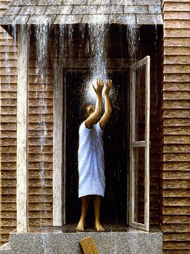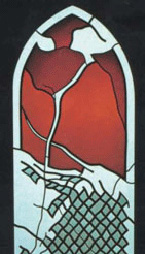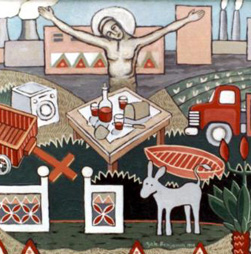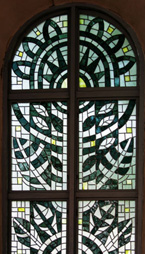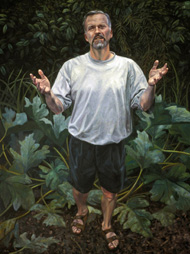Rollins, Tim and K.O.S. - VM - James Romaine
Tim Rollins and K.O.S.: The Seven Last Words of Christ—Terremotto IV (after Haydn)

Duration, Direction, Devotion
by James Romaine
The Seven Last Words of Christ—Terremotto IV (after Haydn) by Tim Rollins and K.O.S. directs our contemplation of Christ’s passion on the cross by slowing us down. Designed to clear our minds of the ambitions that drive us and the concerns that weigh on us, this work focuses our attention on the eternal consequence of Christ.
The Seven Last Words of Christ challenges how we approach works of devotional art. When we say that a work of art encourages us in spiritual meditation, we often mean that its subject gives us something to think about. For example, Matthias Grünewald’sCrucifixion in The Isenheim Altarpiece confronts us with the physical and spiritual gravity of the event. Nevertheless, we should not forget that this Crucifixion was the “closed” state of the altarpiece. This work was designed with moveable wings, which opened to reveal other panels, including a glorious Resurrection.
Today, the disassembled stages of the altarpiece are all on view together. However, we were not meant to see the Crucifixion andResurrection simultaneously. The work was designed to be engaged over a period of time. The very structure of the altarpiece was meditative; it required patience. Since the wings were only opened on holy days, the viewer had to wait for the resurrection to be revealed. This waiting time was part of The Isenheim Altarpiece’s function as an instrument of spiritual training. Grünewald’s work was designed to actively change you, not just provide a passive moment of reflection.
Time is also an important dimension of Franz Joseph Haydn’s musical score. Haydn’s The Seven Last Words of Christ cannot be heard all in one moment. Performances of the entire score, which has seven main sections as well as an introduction and “earthquake” (terremotto) conclusion, take longer than an hour. In time, the composer takes us on an emotional and spiritual journey.

Employing one page from each section of Haydn’s score, Rollins and K.O.S.’ The Seven Last Words of Christ is composed of nine panels. (Painting on pages, either book pages or a musical score, is a signature element of Rollins and K.O.S.’ art.) Each panel is painted in spinel black. Black spinel is a rare gemstone that has associations with fidelity and devotion as well as the consolation of melancholy. As a crushed pigment, spinel black has a rich matte surface. Each panel is painted leaving a vertical strip that is left unpainted down the middle of the panel. We can call these “zips” to acknowledge their kinship with the art of Barnett Newman, specifically his well-known series Stations of the Cross.
The “zip” can be read simultaneously as a white form standing against the void and as a tear in the black form. In the first reading, the “zip” could be a surrogate figure of Christ or perhaps a visualization of Christ’s words cried out into the darkness. In the second reading, the “zip” may evoke the renting of the temple veil at the hour of Christ’s death. Perhaps this severance reminds us thatGrünewald designed his own image of Christ to be ripped apart when the altarpiece was opened. The confrontational iconography ofThe Seven Last Words of Christ is richly personal and gripping; each viewer finds something new in it.
The entire work, nine panels hung in a row, is 271 cm long. Each panel is 23 cm wide. The panels are separated by spaces of 8 cm. These spaces are significant to the work. They are visual pauses between each panel; breaths between each saying of Christ.
The structure of The Seven Last Words of Christ requires that it be seen “in time.” It is not possible to read this work from one single place. We stand back to take in the entire work. We approach each panel individually to read what remains discernable of the musical score. The succession of panels moves us corporally. In The Isenheim Altarpiece, the physical pose of each figure evokes certain states of spiritual being. The Seven Last Words of Christ employs our own bodies, as its composition directs our movement, to develop our spiritual contemplation.
Echoing the time-based structure of Haydn’s music, Rollins and K.O.S. have created a work that restores important aspects of duration and direction that have often been deemphasized in works of devotional art which encourage passive, momentary, and undirected reflection. We don’t often encounter contemporary devotional art that addresses the method of our meditation. The Seven Last Words of Christ affects us, just as The Isenheim Altarpiece altered the late-gothic worshiper. Rollins and K.O.S. are true heirs ofGrünewald and Newman. Particularly in this season of lent, The Seven Last Words of Christ urges us to take the time to contemplate Christ’s passion.
*******
Tim Rollins and K.O.S.: The Seven Last Words of Christ—Terremotto IV (after Haydn), 2013, black spinel pigment, casein, music score pages on wood panels, 30,5 × 271 × 1 cm. Courtesy: The Artist and Xavier Hufkens, Brussels. Photo-credit: Allard Bovenberg, Amsterdam.
Tim Rollins and K.O.S. Tim Rollins was born in Pittsfield, Massachusetts, USA, in 1955. He lives and works in New York. He is an artist, teacher and activist who began his career as the assistant of the conceptual artist Joseph Kosuth. In 1979 he founded Group Material in New York. In the early 1980s he taught ‘at risk’ students with learning disabilities at Intermediate School 52 in the Bronxand went on to create the Art & Knowledge Workshop. His highly acclaimed collaboration with the members of K.O.S. (Kids of Survival) continues to this day. Rollins combines lessons in reading and writing with making artworks. The source material laid out and studied by the students generally relates to literary or musical classics, such as works by William Shakespeare, George Orwell, Ralph Ellison or Franz Schubert, but can also include comics or legal documents. Their collaborative work takes the form of drawings, photographs, sculptural objects and paintings on canvas and paper. The backgrounds of works are often comprised of pages of books pasted into a grid. The results blend elements of Minimalism with an interest in the revival of painting that took place in the 1980s and in art that is socially and politically engaged. Rollins has said: “What we’re doing changes people’s conception about who can make art, how art is made, who can learn and what’s possible, because a lot of these kids had been written off by the school system. This is our revenge.” Tim Rollins and K.O.S. have been involved in numerous solo and group exhibitions including the Whitney Biennale inNew York in 1985, 1991 and 2006 and Documenta in Kassel in 1987. The original K.O.S. members dispersed and now live in several different American cities. Some have gone on to become artists in their own right. Tim Rollins continues to work with young people via the K.O.S. project. (Taken from www.xavierhufkens.com/artists/tim-rollins-and-kos)
James Romaine is Associate Professor of art history and chair of the Department of Art History at Nyack College, Nyack, NY, USA. He is the president and co-founder of the Association of Scholars of Christianity in the History of Art (ASCHA).
ArtWay Visual Meditation March 16, 2014
